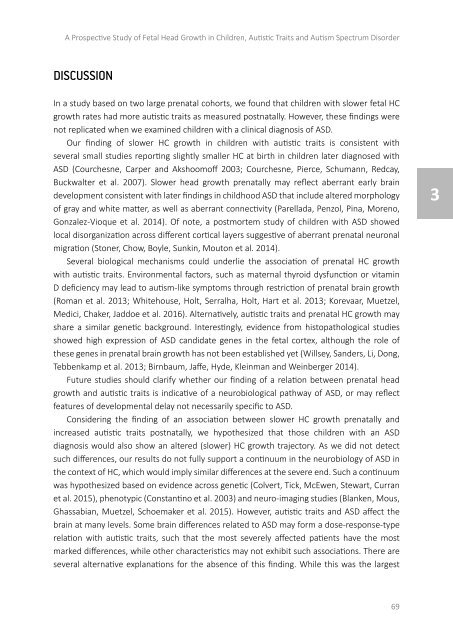On the Spectrum
2lm5UyR
2lm5UyR
You also want an ePaper? Increase the reach of your titles
YUMPU automatically turns print PDFs into web optimized ePapers that Google loves.
A Prospective Study of Fetal Head Growth in Children, Autistic Traits and Autism <strong>Spectrum</strong> Disorder<br />
DISCUSSION<br />
In a study based on two large prenatal cohorts, we found that children with slower fetal HC<br />
growth rates had more autistic traits as measured postnatally. However, <strong>the</strong>se findings were<br />
not replicated when we examined children with a clinical diagnosis of ASD.<br />
Our finding of slower HC growth in children with autistic traits is consistent with<br />
several small studies reporting slightly smaller HC at birth in children later diagnosed with<br />
ASD (Courchesne, Carper and Akshoomoff 2003; Courchesne, Pierce, Schumann, Redcay,<br />
Buckwalter et al. 2007). Slower head growth prenatally may reflect aberrant early brain<br />
development consistent with later findings in childhood ASD that include altered morphology<br />
of gray and white matter, as well as aberrant connectivity (Parellada, Penzol, Pina, Moreno,<br />
Gonzalez-Vioque et al. 2014). Of note, a postmortem study of children with ASD showed<br />
local disorganization across different cortical layers suggestive of aberrant prenatal neuronal<br />
migration (Stoner, Chow, Boyle, Sunkin, Mouton et al. 2014).<br />
Several biological mechanisms could underlie <strong>the</strong> association of prenatal HC growth<br />
with autistic traits. Environmental factors, such as maternal thyroid dysfunction or vitamin<br />
D deficiency may lead to autism-like symptoms through restriction of prenatal brain growth<br />
(Roman et al. 2013; Whitehouse, Holt, Serralha, Holt, Hart et al. 2013; Korevaar, Muetzel,<br />
Medici, Chaker, Jaddoe et al. 2016). Alternatively, autistic traits and prenatal HC growth may<br />
share a similar genetic background. Interestingly, evidence from histopathological studies<br />
showed high expression of ASD candidate genes in <strong>the</strong> fetal cortex, although <strong>the</strong> role of<br />
<strong>the</strong>se genes in prenatal brain growth has not been established yet (Willsey, Sanders, Li, Dong,<br />
Tebbenkamp et al. 2013; Birnbaum, Jaffe, Hyde, Kleinman and Weinberger 2014).<br />
Future studies should clarify whe<strong>the</strong>r our finding of a relation between prenatal head<br />
growth and autistic traits is indicative of a neurobiological pathway of ASD, or may reflect<br />
features of developmental delay not necessarily specific to ASD.<br />
Considering <strong>the</strong> finding of an association between slower HC growth prenatally and<br />
increased autistic traits postnatally, we hypo<strong>the</strong>sized that those children with an ASD<br />
diagnosis would also show an altered (slower) HC growth trajectory. As we did not detect<br />
such differences, our results do not fully support a continuum in <strong>the</strong> neurobiology of ASD in<br />
<strong>the</strong> context of HC, which would imply similar differences at <strong>the</strong> severe end. Such a continuum<br />
was hypo<strong>the</strong>sized based on evidence across genetic (Colvert, Tick, McEwen, Stewart, Curran<br />
et al. 2015), phenotypic (Constantino et al. 2003) and neuro-imaging studies (Blanken, Mous,<br />
Ghassabian, Muetzel, Schoemaker et al. 2015). However, autistic traits and ASD affect <strong>the</strong><br />
brain at many levels. Some brain differences related to ASD may form a dose-response-type<br />
relation with autistic traits, such that <strong>the</strong> most severely affected patients have <strong>the</strong> most<br />
marked differences, while o<strong>the</strong>r characteristics may not exhibit such associations. There are<br />
several alternative explanations for <strong>the</strong> absence of this finding. While this was <strong>the</strong> largest<br />
3<br />
69


